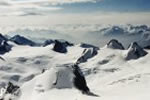


 |
 |
 |
Varves are found in the deposits of glacial lakes. Each varve consists of two distinct layers of sediment, a lower layer of light coloured sandy material and an upper layer of darker silt.
Most melting of the glacier occurs in spring and early summer, so at these times the meltwater streams flow fastest and carry their greatest loads. Fine material is held in suspension in the lake whilst heavier material is deposited.
As autumn and winter approach, the capacity and competence of the meltwater streams is reduced because there is less melting and less meltwater. This allows the finer material, that has been kept in suspension, to settle out and be deposited. Thus, each year, a new set of coarse and fine beds are formed. By counting the number of varves in the lake sediments it is possible to establish the age of the lake.
The varying thicknesses of the varves provides information about climatic conditions. Thick varves are the result of increased deposition, caused by warmer temperatures and increased melting. Thin varves suggest little deposition because of reduced melting and outwash.
Analysis of organic debris extracted from the varves can also provide information about plant types existing at the time of deposition, giving more information about the climatic conditions.
We value
your ideas and suggestions. Please contact the
maintainer of this site.
This page
can be found at: http://www.geography-site.co.uk
Last update to
this statement was on:
February 23, 2006
© Copyright Geography Site